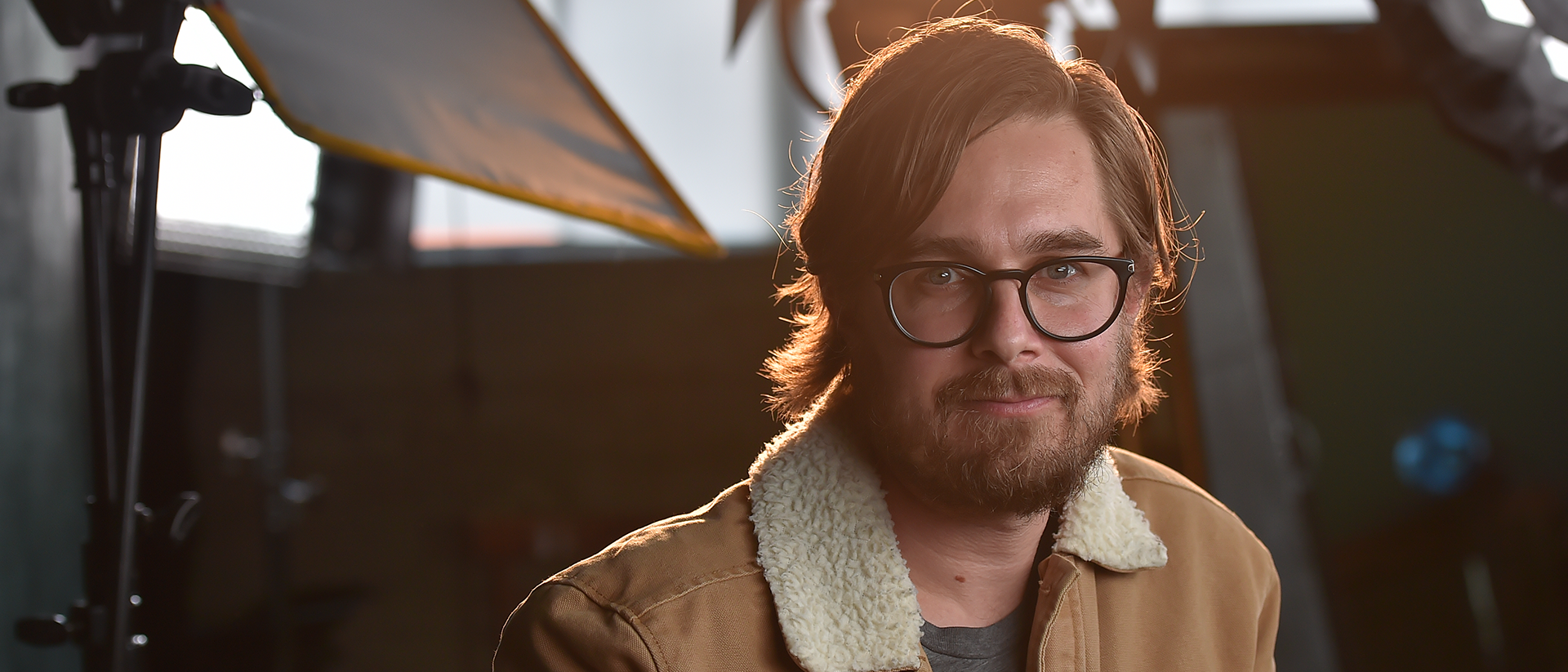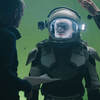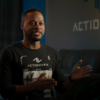VFX Innovation as a Goal | An Interview with Hyphenate’s Travis Button
November 3, 2022
Jonathan Fields
In this interview, we're joined by Director and VFX Supervisor Travis Button to talk about how his background has helped him become the lead creative force for his company Hyphenate.
Today, we welcome director and VFX artist, Travis Button. He's the principal visual effects director for Hyphenate; a VFX company that has had its work featured in TV shows like Parks and Recreation and commercials for brands such as ASUS and Five-Hour Energy.
Q: Thank you, Travis, for taking the time out of your day to speak with me and for your support of ActionVFX.
A: Yeah, thank you for having me. I'm excited to be here talking with you today.
Q: We were incredibly impressed with the reel you submitted - the clients you have worked with in the past (ASUS, Blizzard Entertainment, Warner Music, Mike’s Hard Lemonade) and the way you utilized our assets in your projects. You have a keen eye for detail and a passion for your work.
Can you tell us a little bit about your decision to try and modify our assets so they wouldn't stand out as much in your finished projects?
A: I'll just say, first of all, ActionVFX has been an immeasurable resource for us throughout the years; the company is constantly expanding its catalog and library, which is incredible. I've used all sorts of different stock VFX elements in my 15-year career - for compositing-related things, smoke, explosions, and so on - and nothing else compares to the quality of ActionVFX's products.
So one of the things we try to do is make our assets feel unique or integrate them in a way that people won't always be able to spot them right away as an ActionVFX element. You know, I'm so familiar with your guy's assets, and occasionally you'll see them used in things. And you'll be like, oh, that's ActionVFX, you know, and that's cool.
But what we try to do is manipulate them to make them feel more unique. We love how versatile they are! You can use them as is, or put your own spin on them to make each project unique.
And even if you did use them just out of the box, they would be so incredible. They work great!
I think that as product managers, we always try to push the envelope a little bit further or add some additional element to evolve the product from its starting point. There are occasions where you're just in a crunch and you need a really good element to use right away and you just throw it in there and it works perfectly.
That's what's so great about the elements - they just work. Which is awesome.
Q: What originally got you into doing visual effects?
A: That's a great question. I grew up in a very small farming town in Northwest Kansas. I never really had any involvement or interest in the VFX industry until I was much older, but I've always been fascinated by art and computers from a young age.
I built my first computer when I was around eleven or twelve years old and from then on, I was motivated to keep learning about technology. I had taught myself how to use Photoshop and I was interested in photography, but when I got older, I became more interested in the work of Pixar and other animated movies.
That's what caught my attention and got me to start researching different schools that taught visual effects. I wanted to find a school that used Renderman Shading Language (RSL), which is Pixar's proprietary shading language, and SCAD Savannah College of Art and Design was the only school in the country that used it.
In the end, that's what helped me make my decision. I submitted my portfolio and was lucky enough to receive a partial scholarship based on my photography and artwork. I've always been inclined towards traditional art, like drawing and painting since I was young.
I decided to go to college to learn something entirely new. I was interested in animation and visual effects and wanted to dive in and learn as much as possible. That's what led me to visual effects.
Q: What inspires you the most, and has that changed at all over the years?
A: Yeah, I would say that my goals have changed since I first started out of school. I was originally inspired by Pixar and feature films, but the more I got into school and started learning about different areas, like compositing and 3D animation, the more my goals changed.
I learned that there's a lot more to the industry than just feature films and that there are other areas that I'm passionate about and could see myself working in. I started out doing a bit of everything related to visual effects, but I quickly found my niche in compositing.
I've stuck with it since and I'm pretty versed in all aspects of compositing by now. It's what I originally built my freelance career on and it's still what I'm doing today.
The point at which I moved out to LA and got my first job in commercials was when I realized that I was interested in working in a fast-paced, high-demand environment, as opposed to working on feature films where you could work on a single shot for months at a time. I liked it because it was a more challenging and demanding environment for me.
I'm inspired by challenges - I love it when a job comes through that we have to do something entirely new or innovative that maybe no one else has done before, especially if we haven't done it before. It's always exciting to try something that hasn't been done before and see if we can make it work.
I'm always looking for new things to learn and do in my work. It's what keeps me inspired and motivated to continue evolving as an artist and business owner.
I feel very strongly about always growing and developing my skills, so that's a huge source of inspiration for me. I'm constantly impressed by all the innovative work that other companies are doing, and that drives me to push myself even further. I find inspiration in the work of many different visual effects companies, both big and small. They're all doing such great work that it's hard to choose just one that inspires me the most.
Q: I think that's a common thread that I've seen from the Featured Artists that have sent in their reels to the commercials and music videos that you sent over. It’s a constant need for innovation.
So you mentioned your company Hyphenate. I know things are picking back up and businesses are almost back to usual. What is the future looking like for Hyphenate?
A: The future looks bright - and we're already making great progress! In 2022, we hired our first full-time artist in addition to me.
We usually work with freelance artists on a project-to-project basis, but I have a lot of friends and colleagues that I have established great relationships with over the years. Those are the teams that I try to put together.
We also hired our first colorist! His name is Duran Castro. He's an amazing talent and we're thrilled to have him on board to help us push the boundaries of what's possible with color in our services at Hyphenate.
We're always striving to evolve and improve our offerings, and with Duran's help, we'll be able to take our colorwork to the next level. This is also great news from a sales perspective, as we'll be able to bring in more clients who are specifically looking for high-quality color services. And of course, it's also great for us from a production standpoint as we'll be able to keep our entire pipeline contained within our studio - from start to finish.
So now that we're in post-production and working on visual effects, we can hold everything in our pipeline, push it through color, and out to final delivery. I have some milestones for the rest of the year, like bringing on full-time personnel. Hopefully, by the end of next year, we'll have five full-time employees and be completely covered.
The line between motion design and visual effects has always been a hard one to draw, but recent work has begun to sway more into the motion design side. The goal is to get more talented people involved in Hyphenate so we can continue to evolve and move things forward.
Q: I know that the visual effects industry, like the film industry, used to be very siloed when it came to disciplines. But nowadays, you have to know a little bit of everything to be successful.
A: It's important to know when you need to delegate tasks and when to let others take the lead. I've learned this the hard way - oftentimes, as an owner, we want to be able to control everything and be the one who knows everything but that's just not sustainable.
You're only one person and there are only so many hours in the day. Instead of trying to do everything yourself, focus on what you're good at and what you enjoy and delegate the rest to someone you trust.
It's important to have people you can trust to help you with things so you're not constantly worried about them in the back of your mind. If you don't have that trust, then your room for growth is very limited. It comes with time and experience to learn who you can trust.
And Hyphenate is the real deal - a legitimate grassroots company that I built up from scratch all on my own. I did it by transitioning from being a freelance artist, which is what my entire career was based on. I've been fortunate to have had some great resources and people to help me along the way.
Being the principal of the company and bringing in new clients is extremely important, but so is being a "Jack of all trades". I think that if you're not a multi-dimensional artist, it's difficult to succeed in today's business world.
With the current landscape and how much things have blended together, I think it'll be a tough journey for any artist that specializes in just one area. The demand from clients is constantly increasing and expectations are higher than ever, so the most successful artists I work with are the ones that can pivot and be versatile with their skill set.
Being able to juggle multiple tasks simultaneously and still excel at all of them is not as common as one might think. People who can do this well are often thought of as "jacks of all trades, masters of none" but that's not entirely accurate. A more accurate way to phrase it would be "a jack of all trades, master of as many as possible."
I think all artists need to believe in their own value and be willing to evolve. Sure, you could spend your whole career specializing in one thing, but eventually, you'll hit a point where your growth starts to flatten out a bit. It's important to keep learning new things and expanding your skills so you can continue to improve and be the best artist you can be.
Trying to learn new things quickly is a good way to start, but you will eventually reach a point where you feel like you're not learning anything new anymore. This happens with most things in life, and it's the same with Nuke compositing.
There will always be more to learn, of course, but at some point, you need to start utilizing other software and tools to make your process more efficient. This is incredibly valuable and everyone should be trying to take advantage of that as much as possible.
Q: Our team does that too and it's something we are asked about when we post job openings for visual effects artists. The question was essential whether or not they could do the job remotely and the answer was no - we need somebody who can be on set and film the assets because that's an important part of the job.
So you understand the process from start to finish, and you get a sense of satisfaction and pride from it. I think that's natural.
And it's especially rewarding when you see the final product and realize that maybe one of our interns had a hand in creating it. They look at it and go, "Oh my gosh, I helped with that."
A: Insanely rewarding, a hundred percent. This is kind of a random story, but my nephew who's 18 came out to visit me for the first time just about a month ago. And he got to help work on some projects - we were filming a short film.
He was able to get a first-hand experience of what it's like working on film sets and he had an incredible time. I was so happy to be able to show him what I do and it made me realize how lucky I am to have such a great career.
At a time when he was here, we were doing a proof of concept for visual effects. We had to add a CG orange onto a person's head, and he helped me build the tracking rig I needed to do to be able to integrate them into the hair and all this stuff.
And when we were done, I was proud of what we had accomplished together. It wasn't just me, he got to see the process and learn as we went along. And I think that's something that's fulfilling for someone who's just learning and dipping their toes into it. To be able to see that.
Being on set is beneficial to see how the process works on that end and how everyone collaborates. For example, a visual effects supervisor would need to collaborate with the director, DP, and the entire crew to make sure they get what is needed before going into post. This way, it is more efficient and effective.
Q: When we got your reel, we also were sent a list of here are the collections, that were used in each of these different things. What got you? What turned you on to ActionVFX is what started.
A: Some of my earliest and most used ActionVFX elements are probably the smoke and fog ones. I honestly think I use them more than any other elements in the library. We have the ActionVFX Drive and it's packed with these great resources.
And so, you know, we usually update it annually to include all of the latest resources. But yeah, in the fog. The fog and smoke. It's probably the most valuable pack to me because it can be used for so many different things.
Even if it's just a subtle atmosphere thing or something, it can add more depth to a shot. And those in the array of just like different looks.
I'm thinking of what different kinds of fog are there and being able to capture all these different things. And I do think that those are probably some of the most important things to get right when trying to create an immersive experience.
We're probably the first ones to do this. There are so many things and I love that you're reaching out to the community and asking what we're planning on doing next.
What is it that you've been looking for in terms of VFX? That isn't in the library right now? Something like that. That we could do on our next shoot.
And I just think that's awesome because I think that's such a valuable insight for everybody out there. All these companies and everyone that's using VFX are asking what's the thing that I went to ActionVFX and looked for, and I couldn't find it. And then making that suggestion or whatever the case may be.
Q: So what’s up next for you and Hyphenate?
A: Our new film and game from Sam Barlow is in development! It's a fully live-action, feature-length film, but it's all fully interactive within a game environment - coming soon to Steam and a few other distributions. This is our first feature and we're excited to share it with everyone soon.
Looking to take your visuals to the next level? Check out our VFX stock footage library for all the latest and greatest in VFX assets. With dozens of different FX available, like flamethrowers, water splashes, blood hits, ground fog, snow, fireworks, and more, you're sure to find what you're looking for.
You can buy asset collections with the FX of your choice separately starting from $50 or subscribe for as low as $14.99 per month to get instant access to our entire library.
Remember to connect with us on our social networks to stay updated on our latest news, giveaways, announcements, and more!
ActionVFX socials:



